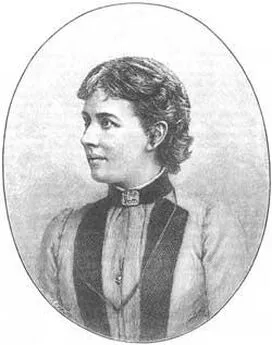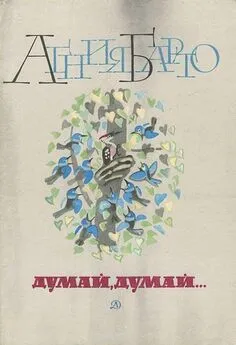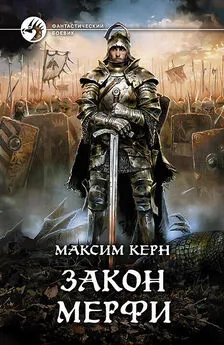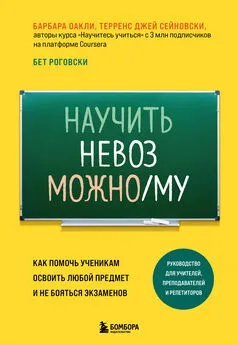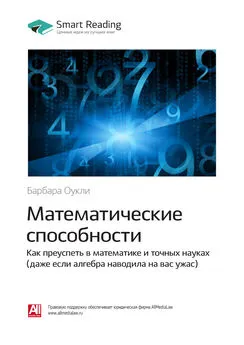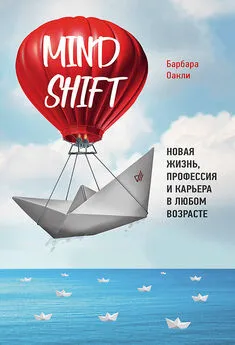Барбара Оакли - Думай как математик
- Название:Думай как математик
- Автор:
- Жанр:
- Издательство:Альпина Паблишер
- Год:2015
- Город:Москва
- ISBN:978-5-9614-3080-6
- Рейтинг:
- Избранное:Добавить в избранное
-
Отзывы:
-
Ваша оценка:
Барбара Оакли - Думай как математик краткое содержание
Прочитав эту книгу, вы научитесь: эффективно решать задачи из любой области знаний; освоите метод интерливинга (чередование разных типов задач); научитесь «сжимать» ключевые идеи так, чтобы их было удобнее удержать в памяти, и узнаете о возможностях своего мозга очень много нового!
Думай как математик - читать онлайн бесплатно ознакомительный отрывок
Интервал:
Закладка:
5. См.: Stephen Christman et al. 2008: 403, где утверждается: «Левое полушарие поддерживает наши текущие мнения, в то время как правое оценивает и обновляет эти мнения, когда нужно. Оценка мнений, таким образом, зависит от взаимодействия между полушариями».
6. Ramachandran 1999: 136.
7. Gazzaniga 2000; Gazzaniga et al. 1996.
8. Фейнман 2011. Изначально представлено в его речи в Калифорнийском политехническом институте в 1974 г.
9. Фейнман, 2011.
10. В работе Alan Baddeley et al. 2009: 148–149 отмечается: «У нас сейчас недостаточно способов защититься от вызовов собственному самоуважению. Мы с готовностью принимаем похвалу, но скептично относимся к критике, часто считая ее плодом предубеждения критикующего. Успех мы готовы считать собственной заслугой, зато вину за неуспех мы отрицаем. Если эта уловка не срабатывает, мы успешно забываем провалы и помним успех и похвалу» (ссылка опущена).
11. Granovetter 1983; Granovetter 1973.
12. Ellis et al. 2003.
13. Beilock 2010: 34.
14. Arum and Roksa 2010: 120.
Глава 17
1. Посетите сайт доктора Фелдера: http://www4.ncsu.edu/unity/lockers/users/f/felder/public/
2. Felder 1999. Использовано с разрешения Ричарда Фелдера и Chemical Engineering Education.
3. Дополнительные материалы на эту тему см. в McClain 2011 и цитируемых там источниках.
4. Beilock 2010: 140–141.
5. Mrazek et al. 2013.
6. В работе Beilock 2010: 60 говорится: «Спортсмены в стрессовой ситуации порой пытаются контролировать свои действия так, что все их усилия оборачиваются к худшему. Такой контроль, часто называемый “паралич от анализа”, есть результат гиперактивности префронтальной зоны коры головного мозга».
7. Beilock 2010; http://www.sianbeilock.com/
Литература
Аллен Д. Как привести дела в порядок. Искусство продуктивности без стресса. — М.: Манн, Иванов и Фербер, 2011.
Гладуэлл М. Гении и аутсайдеры. Почему одним все, а другим ничего? — М.: Манн, Иванов и Фербер, 2012.
Голдакр Б. Обман в науке. — М.: Эксмо, 2010.
Грин Р. Мастер игры. — М.: Рипол Классик, 2014.
Дахигг Ч. Сила привычки. Почему мы живем и работаем именно так, а не иначе. — М.: Карьера Пресс, 2014.
Де Боно Э. Латеральное мышление. — Мн.: Попурри, 2012.
Джеймс У. Беседы с учителями о психологии. — М., 1902.
Джонсон С. Откуда берутся хорошие идеи. — М.: АСТ, 2013.
Дойдж Н. Пластичность мозга: Потрясающие факты о том, как мысли способны менять структуру и функции нашего мозга. — М.: Эксмо, 2010.
Дуэк К. Гибкое сознание. Новый взгляд на психологию развития взрослых и детей. — М.: Манн, Иванов и Фербер, 2013.
Койл Д. Код таланта. — М.: Астрель, ВКТ, 2011.
Колвин Дж. Талант ни при чем! Что на самом деле отличает выдающихся людей? — М.: Альпина Бизнес Букс, 2012.
Лурия А. Р. Маленькая книжка о большой памяти. — М., 1968.
Фейнман Р., Лейтон Р., Сэндс М. Фейнмановские лекции по физике. Выпуск 2. Пространство. Время. Движение. — М.: Мир, 1965.
Фейнман Р. Вы, конечно, шутите, мистер Фейнман! — М.: АСТ, Астрель, 2011.
Фейнман Р. Не все ли равно, что думают другие? — М.: АСТ, 2014.
Феррис Т. Совершенное тело за 4 часа. — М.: Добрая книга, 2013.
Фоер Дж. Эйнштейн гуляет по Луне. Наука и искусство запоминания. — М.: Альпина Паблишер, 2013.
Фьоре Н. Легкий способ перестать откладывать дела на потом. — М.: Манн, Иванов и Фербер, 2013.
Эмметт Р. Книга для лентяя, или Как научиться не откладывать все на потом. — СПб.: Амфора, 2008.
Aaron, R., and R. H. Aaron. Improve Your Physics Grade. New York: Wiley, 1984.
Ainslie, G., and N. Haslam. “Self-control.” In Choice over Time, edited by G. Loewenstein and J. Elster, 177–212. New York: Russell Sage Foundation, 1992.
Amabile, T. M., et al. “Creativity under the gun.” Harvard Business Review 80, 8 (2002): 52.
Amidzic, O. et al. “Pattern of focaly-bursts in chess players.” Nature 412 (2001): 603–604.
Andrews-Hanna, J. R. “The brain’s default network and its adaptive role in internal mentation.” Neuroscientist 18, 3 (2012): 251–270.
Armstrong, J. S. “Natural learning in higher education.” In Encyclopedia of the Sciences of Learning, 2426–2433. New York: Springer, 2012.
Arum, R., and J. Roksa. Academically Adrift. Chicago: University of Chicago Press, 2010.
Baddeley, A., et al. Memory. New York: Psychology Press, 2009.
Baer, M., and G. R. Oldham. “The curvilinear relation between experienced creative time pressure and creativity: Moderating effects of openness to experience and support for creativity.” Journal of Applied Psychology 91, 4 (2006): 963–970.
Baumeister, R. F., and J. Tierney. Willpower. New York: Penguin, 2011.
Beilock, S. Choke. New York: Free Press, 2010.
Bengtsson, S. L., et al. “Extensive piano practicing has regionally specific effects on white matter development.” Nature Neuroscience 8, 9 (2005): 1148–1150.
Bilali, M., et al. “Does chess need intelligence? — A study with young chess players.” Intelligence 35, 5 (2007): 457–470.
Bilali, M., et al. “Why good thoughts block better ones: The mechanism of the pernicious Einstellung (set) effect.” Cognition 108, 3 (2008): 652–661.
Boice, R. Procrastination and Blocking. Westport, CT: Praeger, 1996.
Bouma, A. Lateral Asymmetries and Hemispheric Specialization. Rockland, MA: Swets & Zeitlinger, 1990.
Bransford, J. D, et al. How People Learn. Washington, DC: National Academies Press, 2000.
Brent, R., and R. M. Felder. “Learning by solving solved problems.” Chemical Engineering Education 46, 1 (2012): 29–30.
Brown, J. S., et al. “Situated cognition and the culture of learning.” Educational Researcher 18, 1 (1989): 32–42.
Burson K., et al. “Skilled or unskilled, but still unaware of it: how perceptions of difficulty drive miscalibration in relative comparisons.” Journal of Personality and Social Psychology 90, 1 (2006): 60–77.
Buzan, T. Use Your Perfect Memory. New York: Penguin, 1991.
Cai, Q., et al. “Complementary hemispheric specialization for language production and visuospatial attention.” PNAS 110, 4 (2013): E322—E330.
Cannon, D. F. Explorer of the Human Brain. New York: Schuman, 1949.
Carey, B. “Cognitive science meets pre-algebra.” New York Times, September 2, 2012; http://www.nytimes.com/2013/09/03/science/cognitive-science-meets-pre-algebra.html?ref=science.
Carpenter, S. K., et al. “Using spacing to enhance diverse forms of learning: Review of recent research and implications for instruction.” Educational Psychology Review 24, 3 (2012): 369–378.
Carson, S. H., et al. “Decreased latent inhibition is associated with increased creative achievement in high-functioning individuals.” Journal of Personality and Social Psychology 85, 3 (2003): 499–506.
Cassilhas, R. C., et al. “Spatial memory is improved by aerobic and resistance exercise through divergent molecular mechanisms.” Neuroscience 202 (2012): 309–17.
Cat, J. “On understanding: Maxwell on the methods of illustration and scientific metaphor.” Studies in History and Philosophy of Science Part B 32, 3 (2001): 395–441.
Charness, N., et al. “The role of deliberate practice in chess expertise.” Applied Cognitive Psychology 19, 2 (2005): 151–165.
Chase, W. G., and H. A. Simon. “Perception in chess.” Cognitive Psychology 4, 1 (1973): 55–81.
Chi, M. T. H., et al. “Categorization and representation of physics problems by experts and novices.” Cognitive Science 5, 2 (1981): 121–152.
Chiesa, A., and A. Serretti. “Mindfulness-based stress reduction for stress management in healthy people: A review and meta-analysis.” Journal of Alternative Complementary Medicine 15, 5 (2009): 593–600.
Cho, S., et al. “Hippocampal-prefrontal engagement and dynamic causal interactions in the maturation of children’s fact retrieval.” Journal of Cognitive Neuroscience 24, 9 (2012): 1849–1866.
Christman, S. D., et al. “Mixed-handed persons are more easily persuaded and are more gullible: Interhemispheric interaction and belief updating.” Laterality 13, 5 (2008): 403–426.
Chu, A., and J. N. Choi. “Rethinking procrastination: Positive effects of ‘active’ procrastination behavior on attitudes and performance.” Journal of Social Psychology 145, 3 (2005): 245–264.
Cook, N. D. Tone of Voice and Mind. Philadelphia: Benjamins, 2002.
Cook, N. D. “Toward a central dogma for psychology.” New Ideas in Psychology 7, 1 (1989): 1–18.
Cooper, G., and J. Sweller. “Effects of schema acquisition and rule automation on mathematical problem-solving transfer.” Journal of Educational Psychology 79, 4 (1987): 347.
Cowan, N. “The magical number 4 in short-term memory: A reconsideration of mental storage capacity.” Behavioral and Brain Sciences 24, 1 (2001): 87–114.
Cree, G. S., and K. McRae. “Analyzing the factors underlying the structure and computation of the meaning of chipmunk, cherry, chisel, cheese, and cello (and many other such concrete nouns).” Journal of Experimental Psychology: General 132, 2 (2003): 163–200.
Dali, S. Fifty Secrets of Magic Craftsmanship. New York: Dover, 1948 (reprint 1992).
DeFelipe, J. “Brain plasticity and mental processes: Cajal again.” Nature Reviews Neuro science 7, 10 (2006): 811–817.
DeFelipe, J. Cajal’s Butterflies of the Soul: Science and Art. New York: Oxford University Press, 2010.
DeFelipe, J. “Sesquicentenary of the birthday of Santiago Ramón y Cajal, the father of modern neuroscience.” Trends in Neurosciences 25, 9 (2002): 481–484.
Читать дальшеИнтервал:
Закладка:
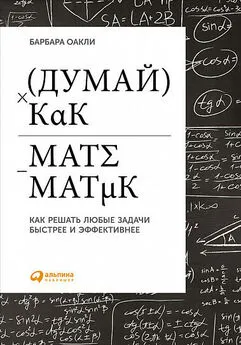

![Айзек Азимов - Думайте! [Думай!]](/books/114896/ajzek-azimov-dumajte-dumaj.webp)
